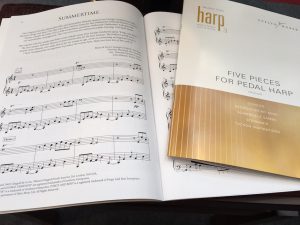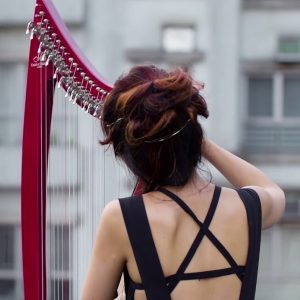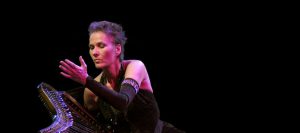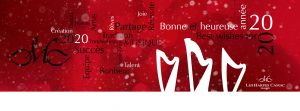Camac Blog
A different dimension: 2HipHarps on Stage
News
October 6, 2023
Whilst visiting Munich for the ARD contest, the Camac team were delighted to catch up with the marvellous Evelyn Huber, one of our favourite artists. We learned from her that she will be playing with another great friend of ours, Deborah Henson Conant together with the Salzburg Philharmonie October 7 and 8. Following a bit of discussion, we learned about the story behind a meeting of musical minds….
You are both known as a harpists who cross many genres, with styles that encompass jazz, world and classical training. Can you tell me how you were inspired to make a different kind of music?
Evelyn Huber: We made folk music in our family.. And where I lived [in Bavaria], we have a smaller pedal harp, it’s a single action pedal harp. I was nine years old, and my sister she had the idea, “oh, a harp would be nice to have in the group!” So, I took harp lessons. And then a few years later, my sister married a musician, and my brother-in-law was into Baroque music and improvising, so a little bit of jazz influence there. We played in groups together and that’s where I started to improvise.
Deborah Henson Conant
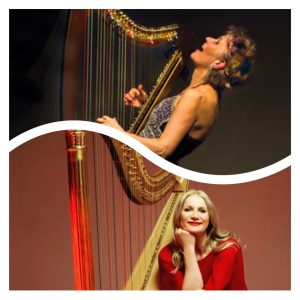
DHC photo: ©Jacob Jacobsen; Evelyn Huber photo: © Christoph Bombart
: When I was seven, my mother, let me play her ukulele, and and she taught me three chords. And I still remember that moment of making the chords with my hands and realising that making patterns on the strings, created music, and I only had to learn three patterns. [Later] I took harp lessons. And I really was fascinated by the mechanics of the harp. But I didn’t like lessons. And I think after that, they [my parents] realised, Oh, I see. She loves music. She wants to know how it works. She doesn’t want lessons. So they stopped trying to give me lessons. And I just started composing, and writing music, musical theatre. In college, I started playing classical music and then I realised I felt constrained. And so I started playing jazz. And then I felt a little more constrained. And so I started writing my own music.
This concert celebrates a musical friendship of many years standing. Where did it all begin?
EH: I met a harpist here in the south of Bavaria. Her name was Sheila, and she already played American rhythms and improvised and I took some lessons from her. Then a few years later, I was 17 (Sweet 17!) [Sheila and] I attended a workshop with a certain American jazz harpist [DHC!]… I went there and I was completely thrilled. And I remember at this time, I had a pony at home, and as I was riding I couldn’t stop grooving and snapping my fingers. I was so full of this music.
DHC: I was invited to come to the Edinburgh harp festival to teach the harp players there how to play the blues. And when I went there, a woman named Nancy Thym-Hochrein, who was an American living in Germany, invited me to come over and do a workshop. And this was the first time I had done I think, a week long workshop in a very unusual place. I think it was almost a cloister or something. And at that workshop, Sheila was there. And that’s where I also met you. So that is where our worlds collided.
Then it seems both of you have encountered elements of overcoming entrenched traditions when it comes to the harp, and the career of the musician?
EH: I knew that I want to go through the lines of classical study, because I wanted to have all this knowledge, I wanted to stand next to classical harpists and to know what they are talking about. So, I had a teacher in my university [Helga Storck], she was very open minded. And she sent me to Caroll McLaughlin in Arizona, because she was classically trained professor at the University of Arizona, but also, she did a lot of jazz. And then I came back and did my diploma and my master degree, but throughout I jammed with jazz musicians. I knew that I had to do my own thing, I knew that I had to develop my own style. And there are the influences from you [Deborah], the influence from Sheila, inspirations from Carol McLaughlin, and I put everything together in a melting pot and make my own thing.
And this you did with help from Deborah?
EH: After my classical study, I knew I had to meet Deborah again. And I asked you (this was this is already over 20 years ago), if I could have lessons. Through you I also got a place to stay and harp on which to practise. And we worked about two months together. You would come in just for 10 minutes or for half an hour. This was a great experience, because we sat together and you played and we tried to analyse what you were doing and we recorded everything. And this was a great way to learn. I still have the recordings actually!
DHC: I would love to see those!
Bringing the conversation back to your current activities then, this coming weekend you will give a concert at the Philharmonie Salzburg under the direction of Elisabeth Fuchs. What inspired you both to create this performance?
EH: I was playing in a group for 12 years; we played jazz and rock music, tango… And we had projects together with a orchestra in Salzburg and conductor Elisabeth Fuchs. So I got to know her, and she asked me a few years ago, if I was willing to come up with a concert program, featuring solo harp in a jazzy style, together with orchestra and I said “Yes, of course!”.And also I, I had a few of my own compositions with orchestrations. And then she said “I discovered a piece in YouTube. We have to play this piece!” And this was Soñada Espanol, your [Deborah’s] composition.
But then there was COVID, and it was not possible. So we recorded it. And you told me after this recording that it’s the first time that anybody recorded the whole thing. We met online, we had some lessons, and we talked about this project. And it was so nice after another 20 years to meet you again and have another project together. And this was like the crowning moment of the of the whole story for me!
DHC: And what’s so powerful about this is if you look back 100 years, you might see a concert with a composer of a concerto. A performer who may have also been writing some of their music, and a conductor. But you will never have seen three women in those positions. So for me, it’s exciting not only to be playing with a symphony, but the idea this could never have happened. There wouldn’t have been electric harps, there wouldn’t have been three women, there wouldn’t have been one with this kind of harp This is the first time there’s ever been anything like this!
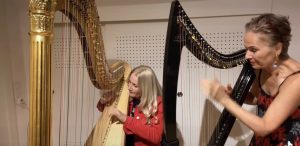
DHC and Evelyn Huber in rehearsal this week
What for you makes this concert so exciting?
EH: In general, audiences are not familiar with the sight of two harps! I like the fact as a musician that you still can surprise the audience with sides of the harp they never heard before. And I think at our concerts, they will hear maybe sides of the harp that they would never expect to hear.
DHC: You’re saying “sides”, which I totally agree with. And I’m also thinking it’s like taking someone into a different dimension. You know, to me, there’s nothing to strumming the harp. Okay, to strum the harp or to play blues, that’s nothing new to me. That’s just part of the vocabulary But it’s new for the audience…
Of course, music making is about collaboration at its core, and that includes collaborating with the instrument. Having worked extremely closely with both Deborah and Evelyn on their respective harps, Camac is thrilled that these two exceptional artists will be using our instruments for this concert!
EH: I’m very happy about my collaboration with Camac, and it’s so nice to represent this part of our lives too.
DHC: It’s really beautiful that we can celebrate our collaboration with Camac in this concert, and celebrate our collaboration with each other and celebrate our collaboration with the Philharmonic all all in one concert.
If you have not already got your tickets and if you’re listening to this, please join us so you can be part of that collaboration, part of that celebration and the beginning of a new part of our story.

